Reviewing Shared Decision-Making: Paradigms & Methodologies in Nursing
VerifiedAdded on 2023/04/20
|12
|2849
|240
Report
AI Summary
This report critically analyzes the research article "Shared Decision-Making for Nursing Practice: An Integrative Review" by Marie Truglio-Londrigan and Jason T. Slyer, focusing on the research paradigms, methodologies, and findings related to shared decision-making (SDM) in nursing. The analysis covers the methodology, design, data collection, literature review, and sampling design used in the original article. It identifies strengths such as the reliability of the research articles used as sources and weaknesses like the exclusion of non-English articles and a focus on Western healthcare systems. The report also discusses the three categories identified for SDM improvement: communication and relationship building, working towards a shared decision, and required actions for SDM. Recommendations are provided to enhance future research, including using primary sources and considering global perspectives. This document provides a comprehensive overview of SDM in nursing research, highlighting key areas for improvement and further study.
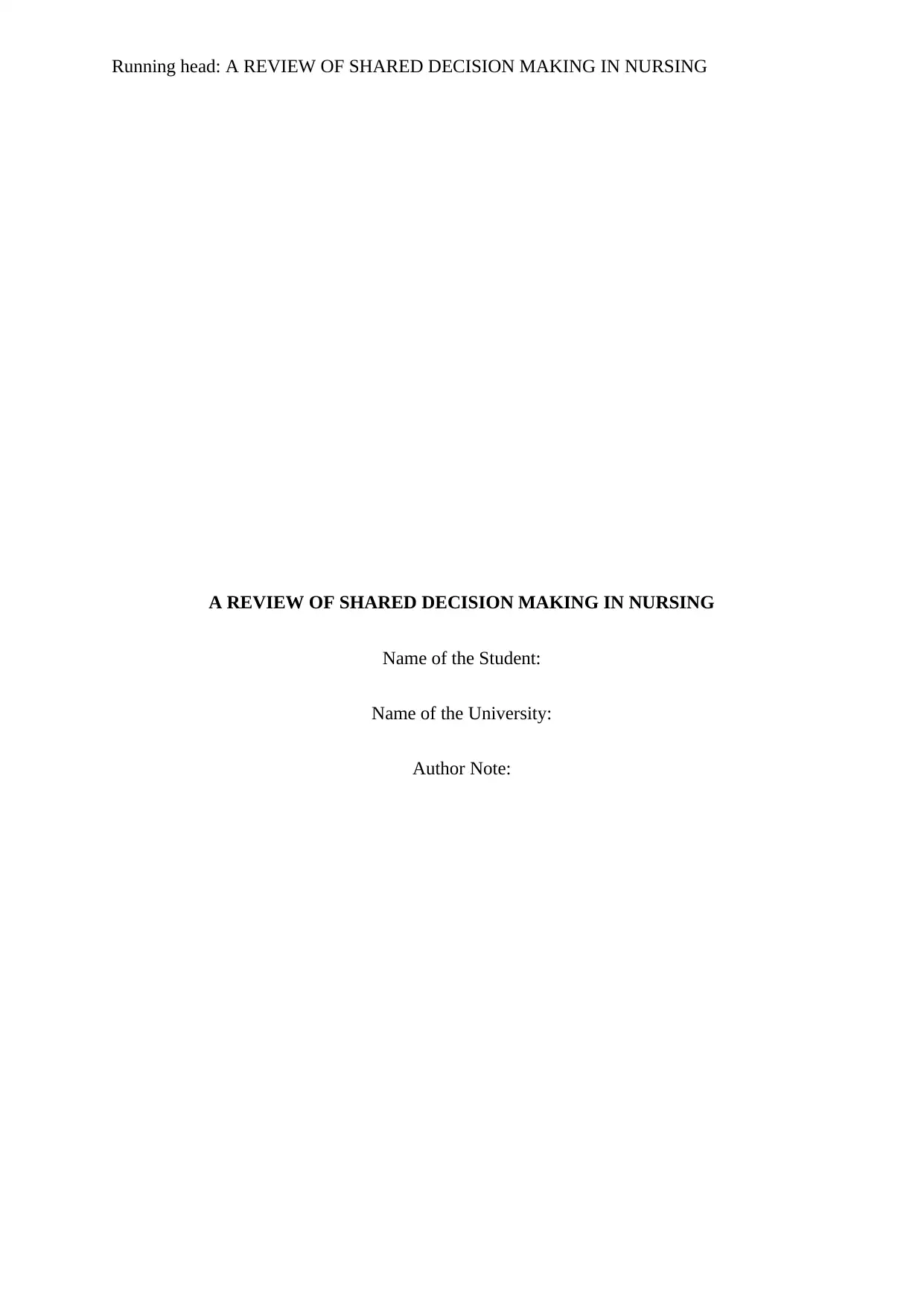
Running head: A REVIEW OF SHARED DECISION MAKING IN NURSING
A REVIEW OF SHARED DECISION MAKING IN NURSING
Name of the Student:
Name of the University:
Author Note:
A REVIEW OF SHARED DECISION MAKING IN NURSING
Name of the Student:
Name of the University:
Author Note:
Paraphrase This Document
Need a fresh take? Get an instant paraphrase of this document with our AI Paraphraser
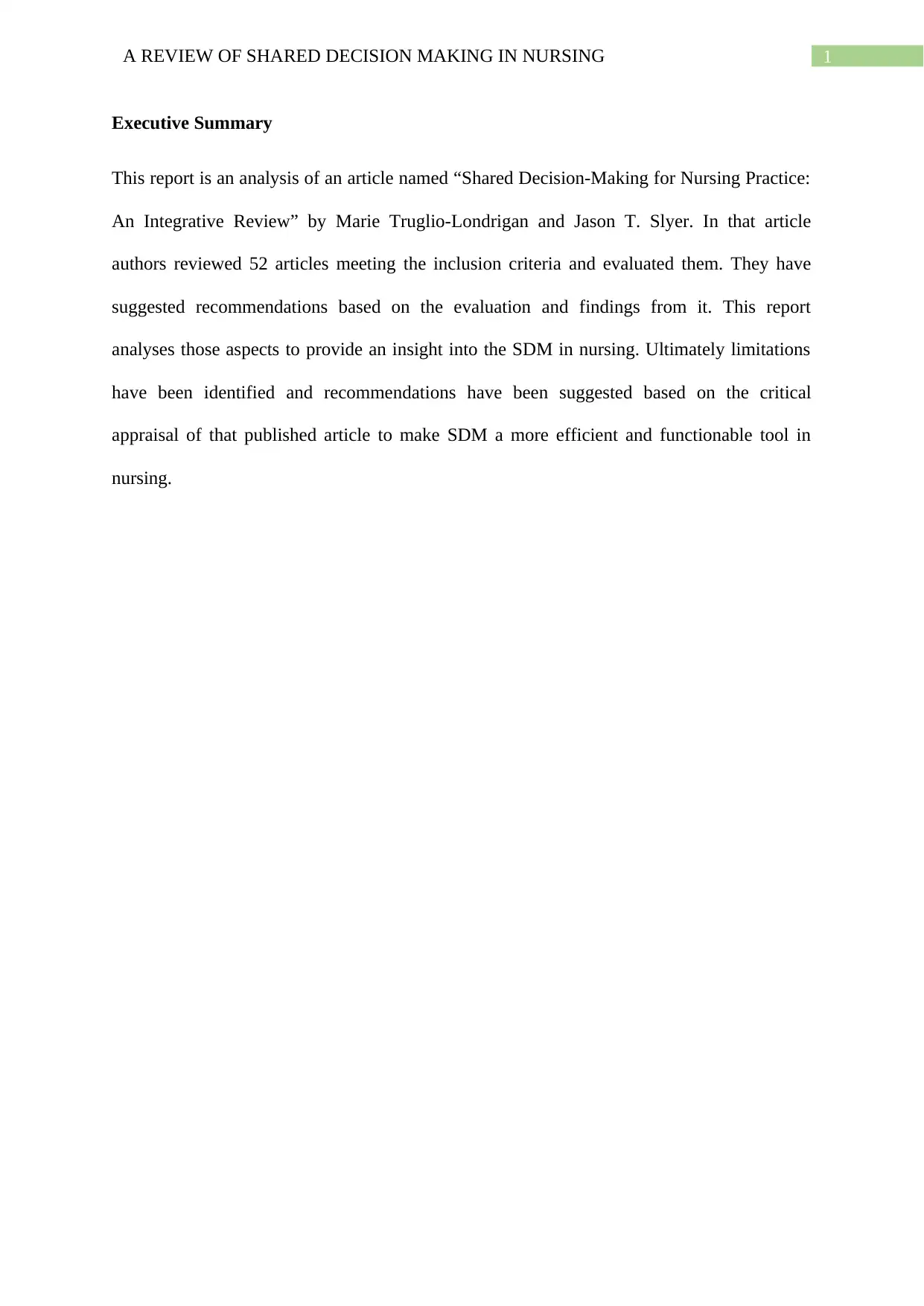
1A REVIEW OF SHARED DECISION MAKING IN NURSING
Executive Summary
This report is an analysis of an article named “Shared Decision-Making for Nursing Practice:
An Integrative Review” by Marie Truglio-Londrigan and Jason T. Slyer. In that article
authors reviewed 52 articles meeting the inclusion criteria and evaluated them. They have
suggested recommendations based on the evaluation and findings from it. This report
analyses those aspects to provide an insight into the SDM in nursing. Ultimately limitations
have been identified and recommendations have been suggested based on the critical
appraisal of that published article to make SDM a more efficient and functionable tool in
nursing.
Executive Summary
This report is an analysis of an article named “Shared Decision-Making for Nursing Practice:
An Integrative Review” by Marie Truglio-Londrigan and Jason T. Slyer. In that article
authors reviewed 52 articles meeting the inclusion criteria and evaluated them. They have
suggested recommendations based on the evaluation and findings from it. This report
analyses those aspects to provide an insight into the SDM in nursing. Ultimately limitations
have been identified and recommendations have been suggested based on the critical
appraisal of that published article to make SDM a more efficient and functionable tool in
nursing.
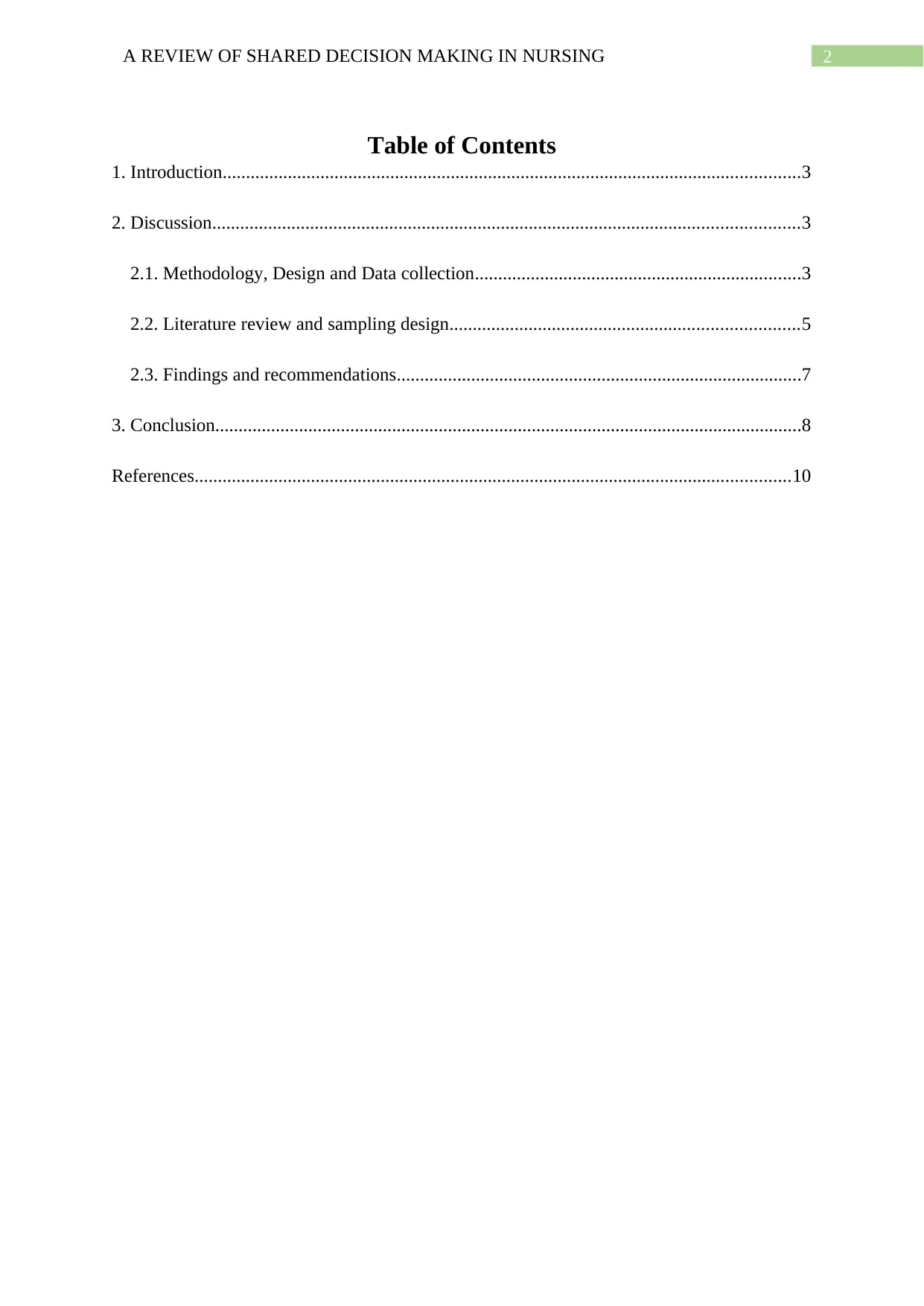
2A REVIEW OF SHARED DECISION MAKING IN NURSING
Table of Contents
1. Introduction............................................................................................................................3
2. Discussion..............................................................................................................................3
2.1. Methodology, Design and Data collection......................................................................3
2.2. Literature review and sampling design...........................................................................5
2.3. Findings and recommendations.......................................................................................7
3. Conclusion..............................................................................................................................8
References................................................................................................................................10
Table of Contents
1. Introduction............................................................................................................................3
2. Discussion..............................................................................................................................3
2.1. Methodology, Design and Data collection......................................................................3
2.2. Literature review and sampling design...........................................................................5
2.3. Findings and recommendations.......................................................................................7
3. Conclusion..............................................................................................................................8
References................................................................................................................................10
⊘ This is a preview!⊘
Do you want full access?
Subscribe today to unlock all pages.

Trusted by 1+ million students worldwide
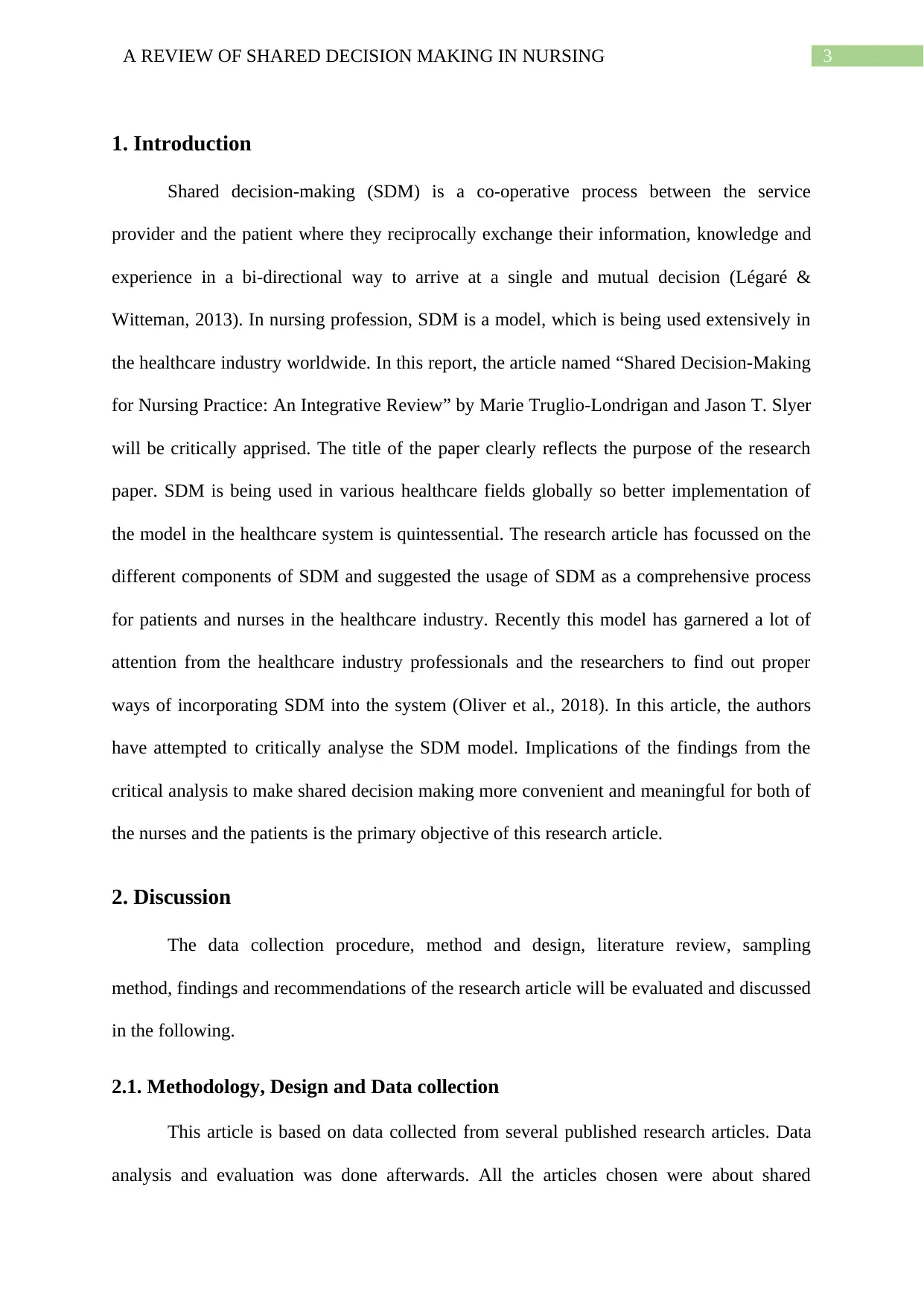
3A REVIEW OF SHARED DECISION MAKING IN NURSING
1. Introduction
Shared decision-making (SDM) is a co-operative process between the service
provider and the patient where they reciprocally exchange their information, knowledge and
experience in a bi-directional way to arrive at a single and mutual decision (Légaré &
Witteman, 2013). In nursing profession, SDM is a model, which is being used extensively in
the healthcare industry worldwide. In this report, the article named “Shared Decision-Making
for Nursing Practice: An Integrative Review” by Marie Truglio-Londrigan and Jason T. Slyer
will be critically apprised. The title of the paper clearly reflects the purpose of the research
paper. SDM is being used in various healthcare fields globally so better implementation of
the model in the healthcare system is quintessential. The research article has focussed on the
different components of SDM and suggested the usage of SDM as a comprehensive process
for patients and nurses in the healthcare industry. Recently this model has garnered a lot of
attention from the healthcare industry professionals and the researchers to find out proper
ways of incorporating SDM into the system (Oliver et al., 2018). In this article, the authors
have attempted to critically analyse the SDM model. Implications of the findings from the
critical analysis to make shared decision making more convenient and meaningful for both of
the nurses and the patients is the primary objective of this research article.
2. Discussion
The data collection procedure, method and design, literature review, sampling
method, findings and recommendations of the research article will be evaluated and discussed
in the following.
2.1. Methodology, Design and Data collection
This article is based on data collected from several published research articles. Data
analysis and evaluation was done afterwards. All the articles chosen were about shared
1. Introduction
Shared decision-making (SDM) is a co-operative process between the service
provider and the patient where they reciprocally exchange their information, knowledge and
experience in a bi-directional way to arrive at a single and mutual decision (Légaré &
Witteman, 2013). In nursing profession, SDM is a model, which is being used extensively in
the healthcare industry worldwide. In this report, the article named “Shared Decision-Making
for Nursing Practice: An Integrative Review” by Marie Truglio-Londrigan and Jason T. Slyer
will be critically apprised. The title of the paper clearly reflects the purpose of the research
paper. SDM is being used in various healthcare fields globally so better implementation of
the model in the healthcare system is quintessential. The research article has focussed on the
different components of SDM and suggested the usage of SDM as a comprehensive process
for patients and nurses in the healthcare industry. Recently this model has garnered a lot of
attention from the healthcare industry professionals and the researchers to find out proper
ways of incorporating SDM into the system (Oliver et al., 2018). In this article, the authors
have attempted to critically analyse the SDM model. Implications of the findings from the
critical analysis to make shared decision making more convenient and meaningful for both of
the nurses and the patients is the primary objective of this research article.
2. Discussion
The data collection procedure, method and design, literature review, sampling
method, findings and recommendations of the research article will be evaluated and discussed
in the following.
2.1. Methodology, Design and Data collection
This article is based on data collected from several published research articles. Data
analysis and evaluation was done afterwards. All the articles chosen were about shared
Paraphrase This Document
Need a fresh take? Get an instant paraphrase of this document with our AI Paraphraser
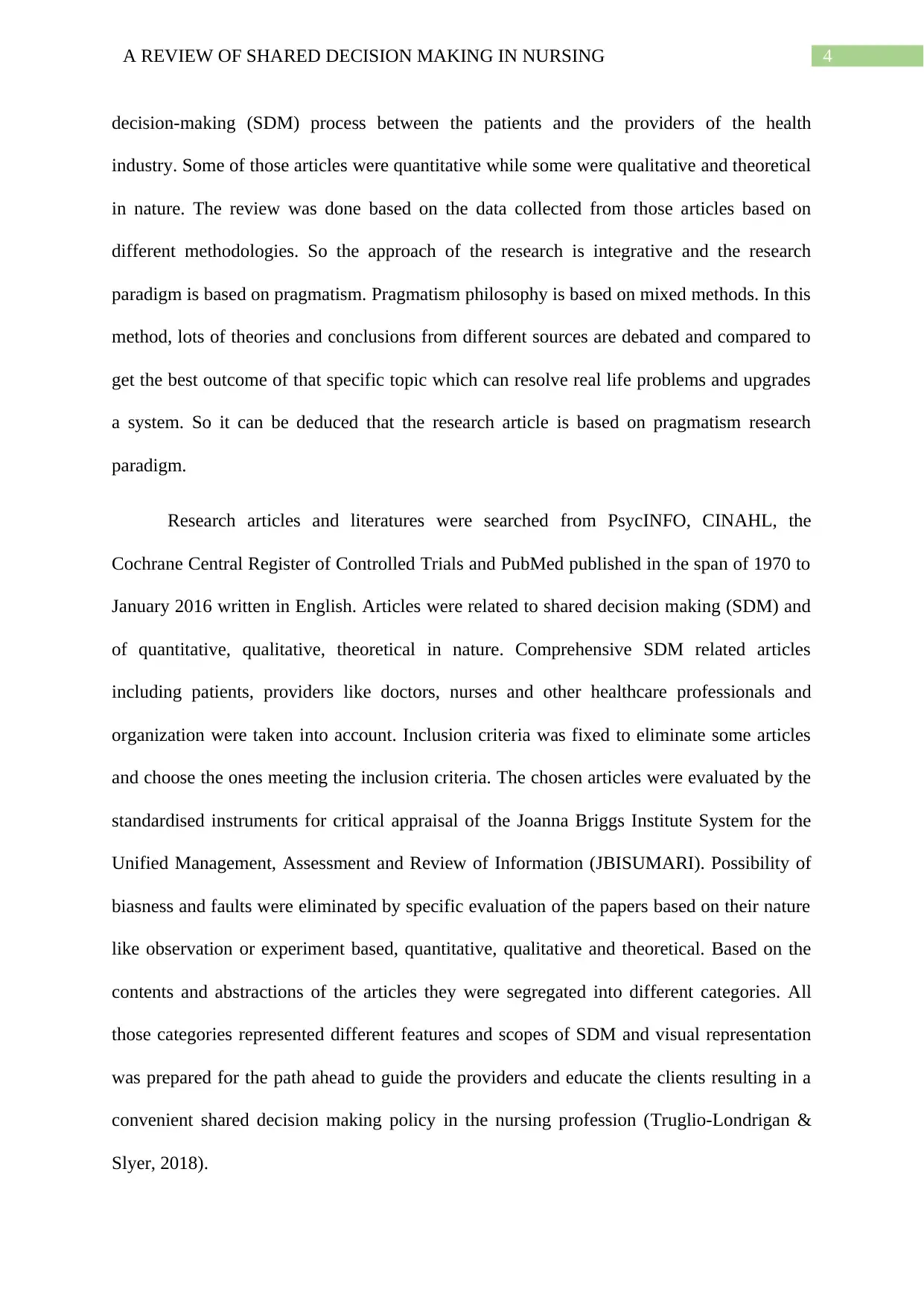
4A REVIEW OF SHARED DECISION MAKING IN NURSING
decision-making (SDM) process between the patients and the providers of the health
industry. Some of those articles were quantitative while some were qualitative and theoretical
in nature. The review was done based on the data collected from those articles based on
different methodologies. So the approach of the research is integrative and the research
paradigm is based on pragmatism. Pragmatism philosophy is based on mixed methods. In this
method, lots of theories and conclusions from different sources are debated and compared to
get the best outcome of that specific topic which can resolve real life problems and upgrades
a system. So it can be deduced that the research article is based on pragmatism research
paradigm.
Research articles and literatures were searched from PsycINFO, CINAHL, the
Cochrane Central Register of Controlled Trials and PubMed published in the span of 1970 to
January 2016 written in English. Articles were related to shared decision making (SDM) and
of quantitative, qualitative, theoretical in nature. Comprehensive SDM related articles
including patients, providers like doctors, nurses and other healthcare professionals and
organization were taken into account. Inclusion criteria was fixed to eliminate some articles
and choose the ones meeting the inclusion criteria. The chosen articles were evaluated by the
standardised instruments for critical appraisal of the Joanna Briggs Institute System for the
Unified Management, Assessment and Review of Information (JBISUMARI). Possibility of
biasness and faults were eliminated by specific evaluation of the papers based on their nature
like observation or experiment based, quantitative, qualitative and theoretical. Based on the
contents and abstractions of the articles they were segregated into different categories. All
those categories represented different features and scopes of SDM and visual representation
was prepared for the path ahead to guide the providers and educate the clients resulting in a
convenient shared decision making policy in the nursing profession (Truglio-Londrigan &
Slyer, 2018).
decision-making (SDM) process between the patients and the providers of the health
industry. Some of those articles were quantitative while some were qualitative and theoretical
in nature. The review was done based on the data collected from those articles based on
different methodologies. So the approach of the research is integrative and the research
paradigm is based on pragmatism. Pragmatism philosophy is based on mixed methods. In this
method, lots of theories and conclusions from different sources are debated and compared to
get the best outcome of that specific topic which can resolve real life problems and upgrades
a system. So it can be deduced that the research article is based on pragmatism research
paradigm.
Research articles and literatures were searched from PsycINFO, CINAHL, the
Cochrane Central Register of Controlled Trials and PubMed published in the span of 1970 to
January 2016 written in English. Articles were related to shared decision making (SDM) and
of quantitative, qualitative, theoretical in nature. Comprehensive SDM related articles
including patients, providers like doctors, nurses and other healthcare professionals and
organization were taken into account. Inclusion criteria was fixed to eliminate some articles
and choose the ones meeting the inclusion criteria. The chosen articles were evaluated by the
standardised instruments for critical appraisal of the Joanna Briggs Institute System for the
Unified Management, Assessment and Review of Information (JBISUMARI). Possibility of
biasness and faults were eliminated by specific evaluation of the papers based on their nature
like observation or experiment based, quantitative, qualitative and theoretical. Based on the
contents and abstractions of the articles they were segregated into different categories. All
those categories represented different features and scopes of SDM and visual representation
was prepared for the path ahead to guide the providers and educate the clients resulting in a
convenient shared decision making policy in the nursing profession (Truglio-Londrigan &
Slyer, 2018).
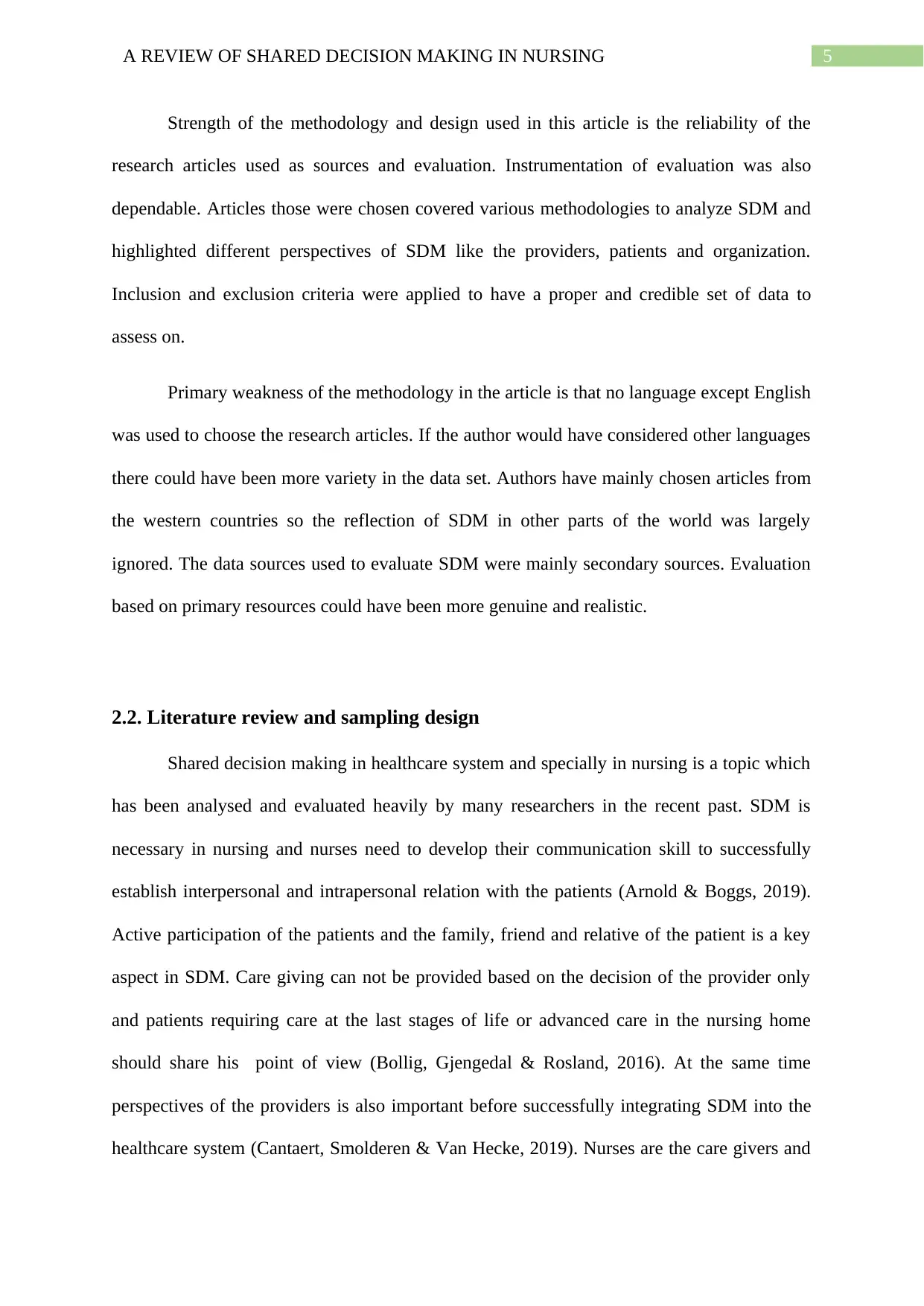
5A REVIEW OF SHARED DECISION MAKING IN NURSING
Strength of the methodology and design used in this article is the reliability of the
research articles used as sources and evaluation. Instrumentation of evaluation was also
dependable. Articles those were chosen covered various methodologies to analyze SDM and
highlighted different perspectives of SDM like the providers, patients and organization.
Inclusion and exclusion criteria were applied to have a proper and credible set of data to
assess on.
Primary weakness of the methodology in the article is that no language except English
was used to choose the research articles. If the author would have considered other languages
there could have been more variety in the data set. Authors have mainly chosen articles from
the western countries so the reflection of SDM in other parts of the world was largely
ignored. The data sources used to evaluate SDM were mainly secondary sources. Evaluation
based on primary resources could have been more genuine and realistic.
2.2. Literature review and sampling design
Shared decision making in healthcare system and specially in nursing is a topic which
has been analysed and evaluated heavily by many researchers in the recent past. SDM is
necessary in nursing and nurses need to develop their communication skill to successfully
establish interpersonal and intrapersonal relation with the patients (Arnold & Boggs, 2019).
Active participation of the patients and the family, friend and relative of the patient is a key
aspect in SDM. Care giving can not be provided based on the decision of the provider only
and patients requiring care at the last stages of life or advanced care in the nursing home
should share his point of view (Bollig, Gjengedal & Rosland, 2016). At the same time
perspectives of the providers is also important before successfully integrating SDM into the
healthcare system (Cantaert, Smolderen & Van Hecke, 2019). Nurses are the care givers and
Strength of the methodology and design used in this article is the reliability of the
research articles used as sources and evaluation. Instrumentation of evaluation was also
dependable. Articles those were chosen covered various methodologies to analyze SDM and
highlighted different perspectives of SDM like the providers, patients and organization.
Inclusion and exclusion criteria were applied to have a proper and credible set of data to
assess on.
Primary weakness of the methodology in the article is that no language except English
was used to choose the research articles. If the author would have considered other languages
there could have been more variety in the data set. Authors have mainly chosen articles from
the western countries so the reflection of SDM in other parts of the world was largely
ignored. The data sources used to evaluate SDM were mainly secondary sources. Evaluation
based on primary resources could have been more genuine and realistic.
2.2. Literature review and sampling design
Shared decision making in healthcare system and specially in nursing is a topic which
has been analysed and evaluated heavily by many researchers in the recent past. SDM is
necessary in nursing and nurses need to develop their communication skill to successfully
establish interpersonal and intrapersonal relation with the patients (Arnold & Boggs, 2019).
Active participation of the patients and the family, friend and relative of the patient is a key
aspect in SDM. Care giving can not be provided based on the decision of the provider only
and patients requiring care at the last stages of life or advanced care in the nursing home
should share his point of view (Bollig, Gjengedal & Rosland, 2016). At the same time
perspectives of the providers is also important before successfully integrating SDM into the
healthcare system (Cantaert, Smolderen & Van Hecke, 2019). Nurses are the care givers and
⊘ This is a preview!⊘
Do you want full access?
Subscribe today to unlock all pages.

Trusted by 1+ million students worldwide
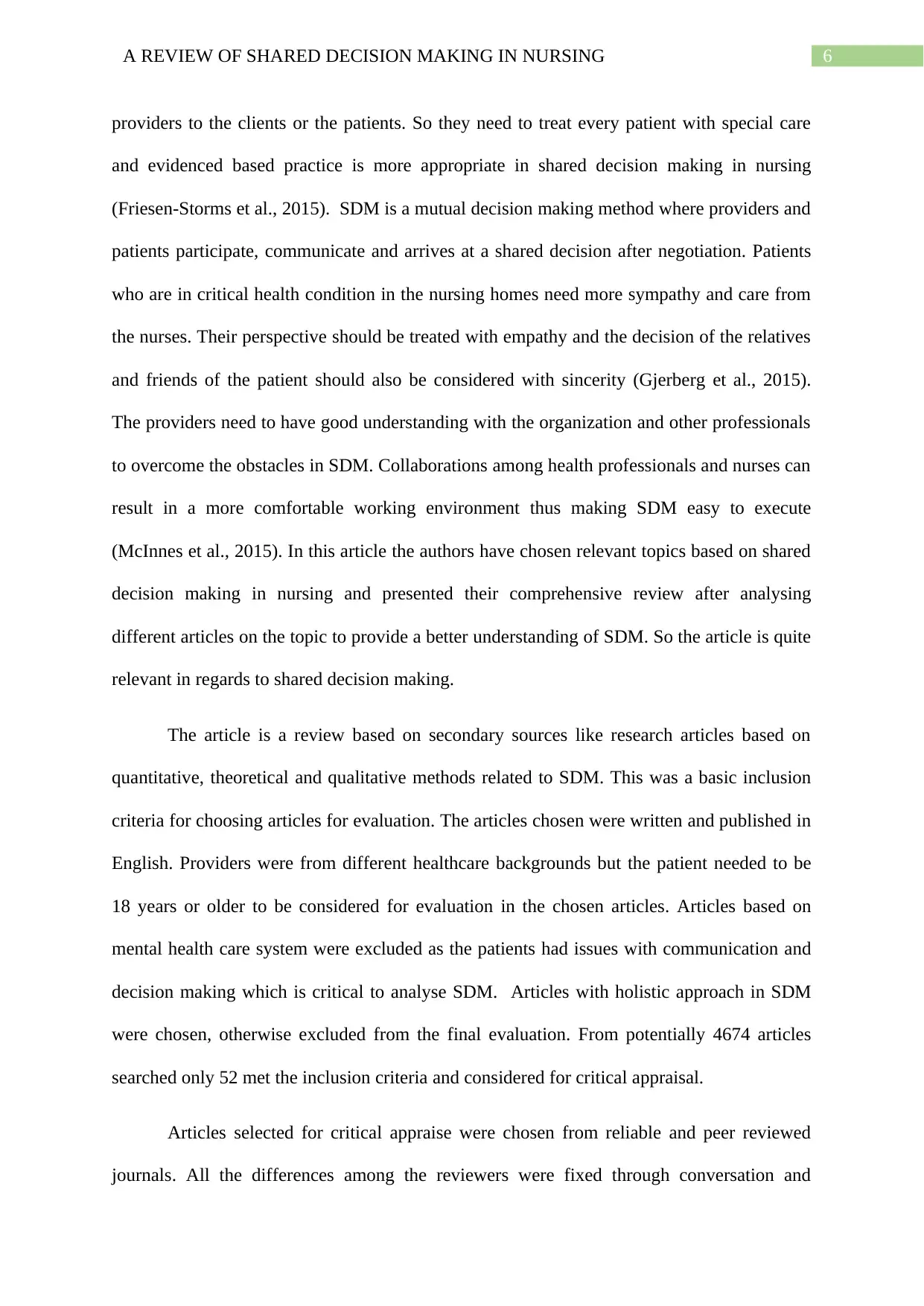
6A REVIEW OF SHARED DECISION MAKING IN NURSING
providers to the clients or the patients. So they need to treat every patient with special care
and evidenced based practice is more appropriate in shared decision making in nursing
(Friesen-Storms et al., 2015). SDM is a mutual decision making method where providers and
patients participate, communicate and arrives at a shared decision after negotiation. Patients
who are in critical health condition in the nursing homes need more sympathy and care from
the nurses. Their perspective should be treated with empathy and the decision of the relatives
and friends of the patient should also be considered with sincerity (Gjerberg et al., 2015).
The providers need to have good understanding with the organization and other professionals
to overcome the obstacles in SDM. Collaborations among health professionals and nurses can
result in a more comfortable working environment thus making SDM easy to execute
(McInnes et al., 2015). In this article the authors have chosen relevant topics based on shared
decision making in nursing and presented their comprehensive review after analysing
different articles on the topic to provide a better understanding of SDM. So the article is quite
relevant in regards to shared decision making.
The article is a review based on secondary sources like research articles based on
quantitative, theoretical and qualitative methods related to SDM. This was a basic inclusion
criteria for choosing articles for evaluation. The articles chosen were written and published in
English. Providers were from different healthcare backgrounds but the patient needed to be
18 years or older to be considered for evaluation in the chosen articles. Articles based on
mental health care system were excluded as the patients had issues with communication and
decision making which is critical to analyse SDM. Articles with holistic approach in SDM
were chosen, otherwise excluded from the final evaluation. From potentially 4674 articles
searched only 52 met the inclusion criteria and considered for critical appraisal.
Articles selected for critical appraise were chosen from reliable and peer reviewed
journals. All the differences among the reviewers were fixed through conversation and
providers to the clients or the patients. So they need to treat every patient with special care
and evidenced based practice is more appropriate in shared decision making in nursing
(Friesen-Storms et al., 2015). SDM is a mutual decision making method where providers and
patients participate, communicate and arrives at a shared decision after negotiation. Patients
who are in critical health condition in the nursing homes need more sympathy and care from
the nurses. Their perspective should be treated with empathy and the decision of the relatives
and friends of the patient should also be considered with sincerity (Gjerberg et al., 2015).
The providers need to have good understanding with the organization and other professionals
to overcome the obstacles in SDM. Collaborations among health professionals and nurses can
result in a more comfortable working environment thus making SDM easy to execute
(McInnes et al., 2015). In this article the authors have chosen relevant topics based on shared
decision making in nursing and presented their comprehensive review after analysing
different articles on the topic to provide a better understanding of SDM. So the article is quite
relevant in regards to shared decision making.
The article is a review based on secondary sources like research articles based on
quantitative, theoretical and qualitative methods related to SDM. This was a basic inclusion
criteria for choosing articles for evaluation. The articles chosen were written and published in
English. Providers were from different healthcare backgrounds but the patient needed to be
18 years or older to be considered for evaluation in the chosen articles. Articles based on
mental health care system were excluded as the patients had issues with communication and
decision making which is critical to analyse SDM. Articles with holistic approach in SDM
were chosen, otherwise excluded from the final evaluation. From potentially 4674 articles
searched only 52 met the inclusion criteria and considered for critical appraisal.
Articles selected for critical appraise were chosen from reliable and peer reviewed
journals. All the differences among the reviewers were fixed through conversation and
Paraphrase This Document
Need a fresh take? Get an instant paraphrase of this document with our AI Paraphraser
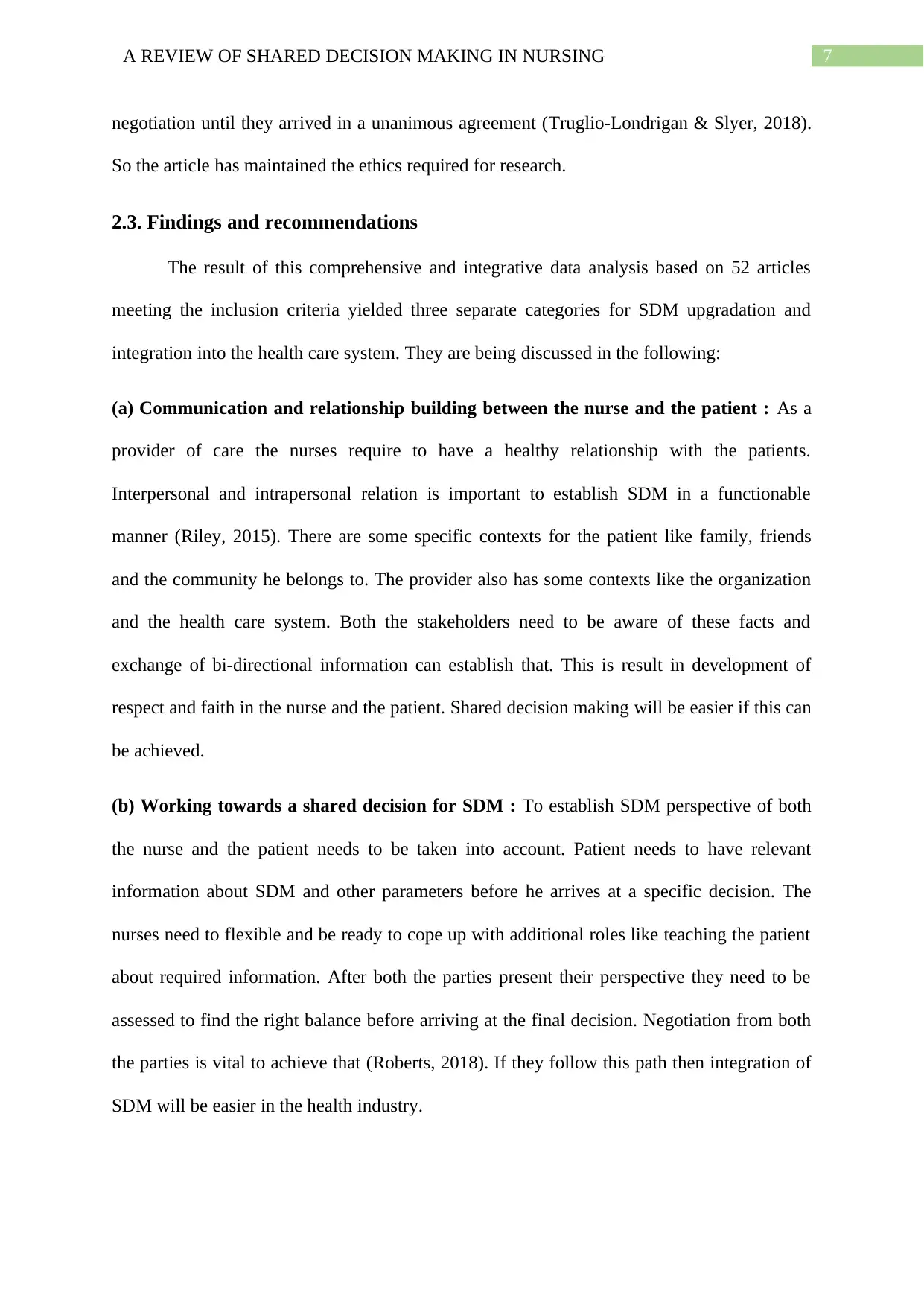
7A REVIEW OF SHARED DECISION MAKING IN NURSING
negotiation until they arrived in a unanimous agreement (Truglio-Londrigan & Slyer, 2018).
So the article has maintained the ethics required for research.
2.3. Findings and recommendations
The result of this comprehensive and integrative data analysis based on 52 articles
meeting the inclusion criteria yielded three separate categories for SDM upgradation and
integration into the health care system. They are being discussed in the following:
(a) Communication and relationship building between the nurse and the patient : As a
provider of care the nurses require to have a healthy relationship with the patients.
Interpersonal and intrapersonal relation is important to establish SDM in a functionable
manner (Riley, 2015). There are some specific contexts for the patient like family, friends
and the community he belongs to. The provider also has some contexts like the organization
and the health care system. Both the stakeholders need to be aware of these facts and
exchange of bi-directional information can establish that. This is result in development of
respect and faith in the nurse and the patient. Shared decision making will be easier if this can
be achieved.
(b) Working towards a shared decision for SDM : To establish SDM perspective of both
the nurse and the patient needs to be taken into account. Patient needs to have relevant
information about SDM and other parameters before he arrives at a specific decision. The
nurses need to flexible and be ready to cope up with additional roles like teaching the patient
about required information. After both the parties present their perspective they need to be
assessed to find the right balance before arriving at the final decision. Negotiation from both
the parties is vital to achieve that (Roberts, 2018). If they follow this path then integration of
SDM will be easier in the health industry.
negotiation until they arrived in a unanimous agreement (Truglio-Londrigan & Slyer, 2018).
So the article has maintained the ethics required for research.
2.3. Findings and recommendations
The result of this comprehensive and integrative data analysis based on 52 articles
meeting the inclusion criteria yielded three separate categories for SDM upgradation and
integration into the health care system. They are being discussed in the following:
(a) Communication and relationship building between the nurse and the patient : As a
provider of care the nurses require to have a healthy relationship with the patients.
Interpersonal and intrapersonal relation is important to establish SDM in a functionable
manner (Riley, 2015). There are some specific contexts for the patient like family, friends
and the community he belongs to. The provider also has some contexts like the organization
and the health care system. Both the stakeholders need to be aware of these facts and
exchange of bi-directional information can establish that. This is result in development of
respect and faith in the nurse and the patient. Shared decision making will be easier if this can
be achieved.
(b) Working towards a shared decision for SDM : To establish SDM perspective of both
the nurse and the patient needs to be taken into account. Patient needs to have relevant
information about SDM and other parameters before he arrives at a specific decision. The
nurses need to flexible and be ready to cope up with additional roles like teaching the patient
about required information. After both the parties present their perspective they need to be
assessed to find the right balance before arriving at the final decision. Negotiation from both
the parties is vital to achieve that (Roberts, 2018). If they follow this path then integration of
SDM will be easier in the health industry.
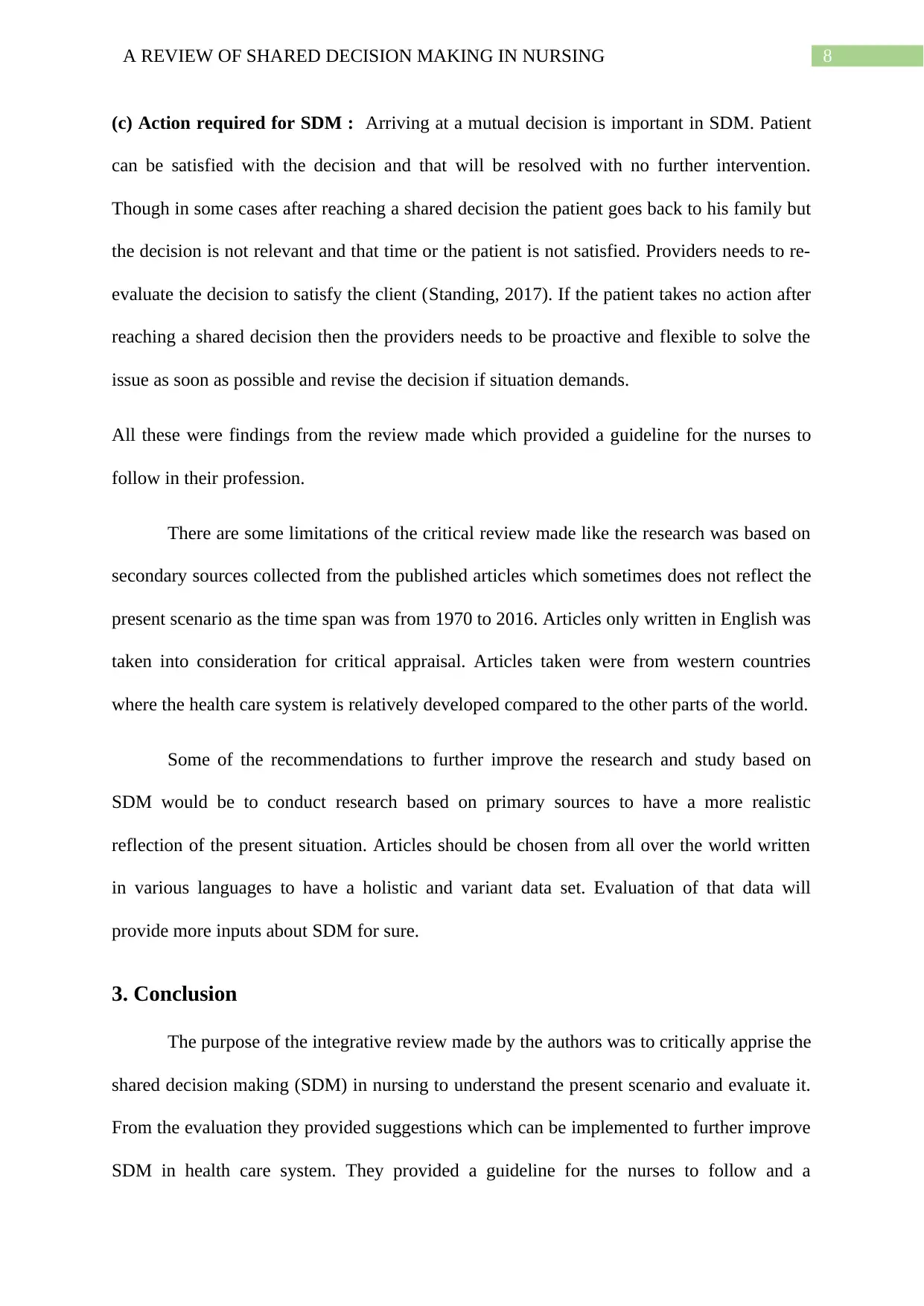
8A REVIEW OF SHARED DECISION MAKING IN NURSING
(c) Action required for SDM : Arriving at a mutual decision is important in SDM. Patient
can be satisfied with the decision and that will be resolved with no further intervention.
Though in some cases after reaching a shared decision the patient goes back to his family but
the decision is not relevant and that time or the patient is not satisfied. Providers needs to re-
evaluate the decision to satisfy the client (Standing, 2017). If the patient takes no action after
reaching a shared decision then the providers needs to be proactive and flexible to solve the
issue as soon as possible and revise the decision if situation demands.
All these were findings from the review made which provided a guideline for the nurses to
follow in their profession.
There are some limitations of the critical review made like the research was based on
secondary sources collected from the published articles which sometimes does not reflect the
present scenario as the time span was from 1970 to 2016. Articles only written in English was
taken into consideration for critical appraisal. Articles taken were from western countries
where the health care system is relatively developed compared to the other parts of the world.
Some of the recommendations to further improve the research and study based on
SDM would be to conduct research based on primary sources to have a more realistic
reflection of the present situation. Articles should be chosen from all over the world written
in various languages to have a holistic and variant data set. Evaluation of that data will
provide more inputs about SDM for sure.
3. Conclusion
The purpose of the integrative review made by the authors was to critically apprise the
shared decision making (SDM) in nursing to understand the present scenario and evaluate it.
From the evaluation they provided suggestions which can be implemented to further improve
SDM in health care system. They provided a guideline for the nurses to follow and a
(c) Action required for SDM : Arriving at a mutual decision is important in SDM. Patient
can be satisfied with the decision and that will be resolved with no further intervention.
Though in some cases after reaching a shared decision the patient goes back to his family but
the decision is not relevant and that time or the patient is not satisfied. Providers needs to re-
evaluate the decision to satisfy the client (Standing, 2017). If the patient takes no action after
reaching a shared decision then the providers needs to be proactive and flexible to solve the
issue as soon as possible and revise the decision if situation demands.
All these were findings from the review made which provided a guideline for the nurses to
follow in their profession.
There are some limitations of the critical review made like the research was based on
secondary sources collected from the published articles which sometimes does not reflect the
present scenario as the time span was from 1970 to 2016. Articles only written in English was
taken into consideration for critical appraisal. Articles taken were from western countries
where the health care system is relatively developed compared to the other parts of the world.
Some of the recommendations to further improve the research and study based on
SDM would be to conduct research based on primary sources to have a more realistic
reflection of the present situation. Articles should be chosen from all over the world written
in various languages to have a holistic and variant data set. Evaluation of that data will
provide more inputs about SDM for sure.
3. Conclusion
The purpose of the integrative review made by the authors was to critically apprise the
shared decision making (SDM) in nursing to understand the present scenario and evaluate it.
From the evaluation they provided suggestions which can be implemented to further improve
SDM in health care system. They provided a guideline for the nurses to follow and a
⊘ This is a preview!⊘
Do you want full access?
Subscribe today to unlock all pages.

Trusted by 1+ million students worldwide
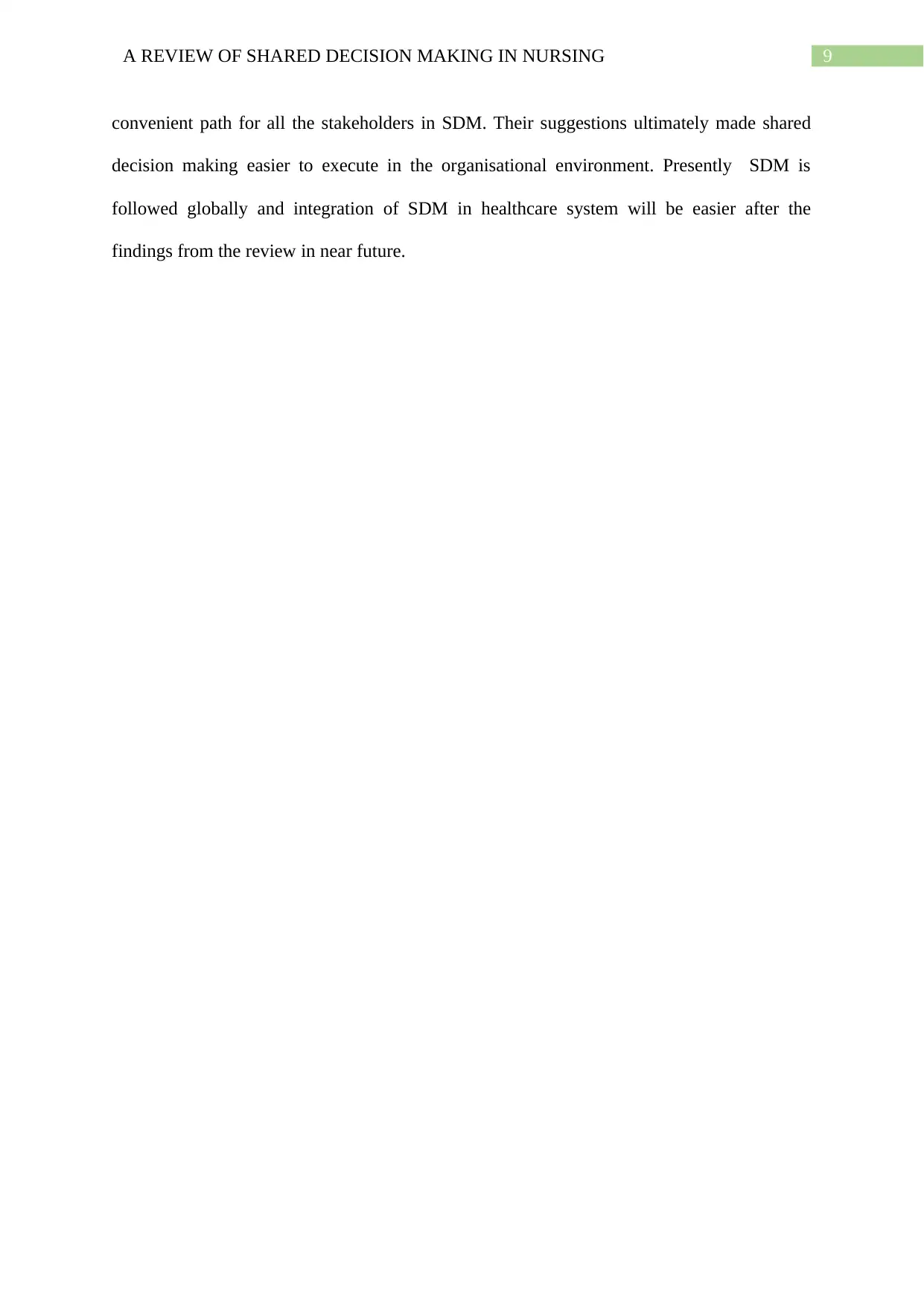
9A REVIEW OF SHARED DECISION MAKING IN NURSING
convenient path for all the stakeholders in SDM. Their suggestions ultimately made shared
decision making easier to execute in the organisational environment. Presently SDM is
followed globally and integration of SDM in healthcare system will be easier after the
findings from the review in near future.
convenient path for all the stakeholders in SDM. Their suggestions ultimately made shared
decision making easier to execute in the organisational environment. Presently SDM is
followed globally and integration of SDM in healthcare system will be easier after the
findings from the review in near future.
Paraphrase This Document
Need a fresh take? Get an instant paraphrase of this document with our AI Paraphraser
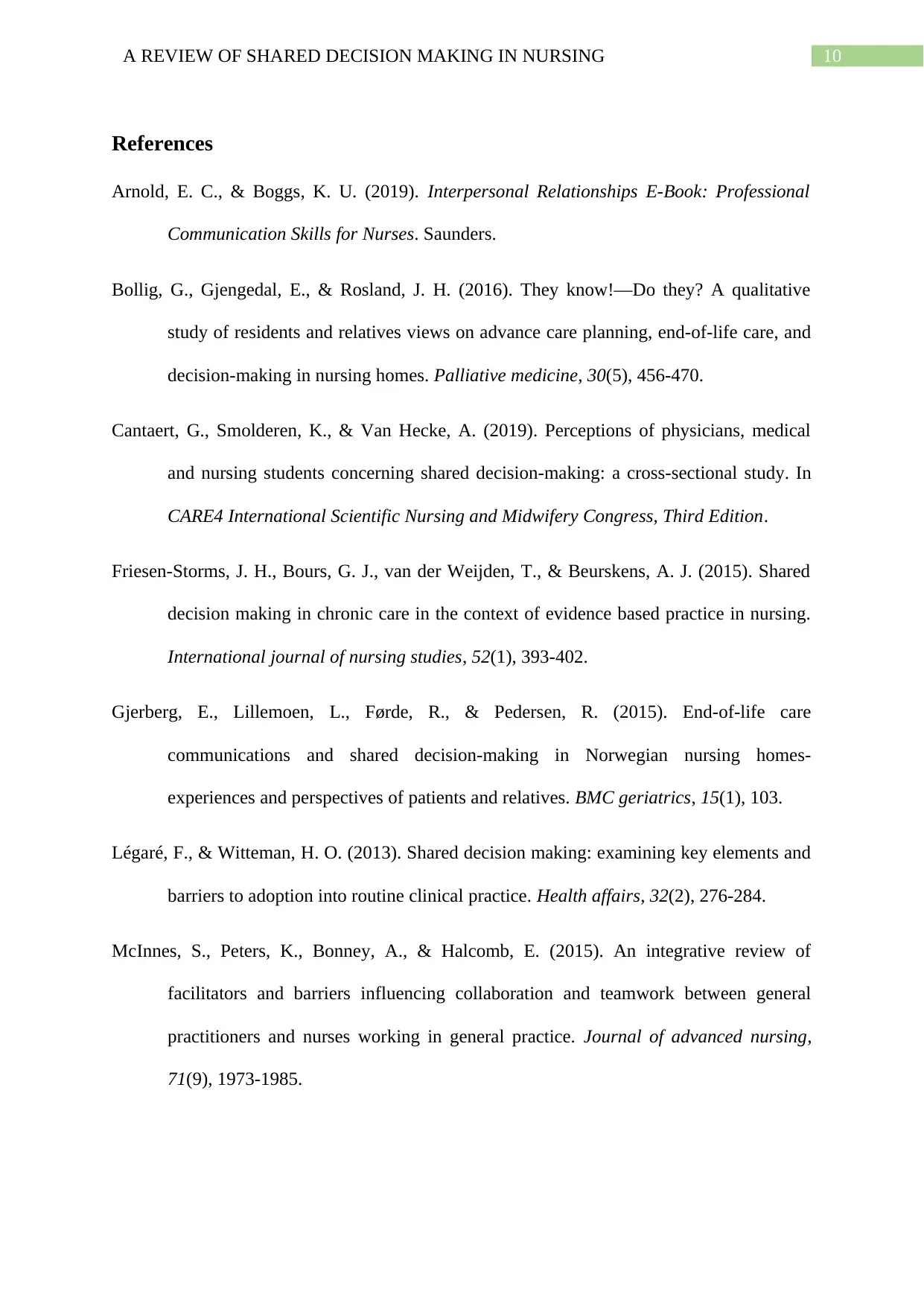
10A REVIEW OF SHARED DECISION MAKING IN NURSING
References
Arnold, E. C., & Boggs, K. U. (2019). Interpersonal Relationships E-Book: Professional
Communication Skills for Nurses. Saunders.
Bollig, G., Gjengedal, E., & Rosland, J. H. (2016). They know!—Do they? A qualitative
study of residents and relatives views on advance care planning, end-of-life care, and
decision-making in nursing homes. Palliative medicine, 30(5), 456-470.
Cantaert, G., Smolderen, K., & Van Hecke, A. (2019). Perceptions of physicians, medical
and nursing students concerning shared decision-making: a cross-sectional study. In
CARE4 International Scientific Nursing and Midwifery Congress, Third Edition.
Friesen-Storms, J. H., Bours, G. J., van der Weijden, T., & Beurskens, A. J. (2015). Shared
decision making in chronic care in the context of evidence based practice in nursing.
International journal of nursing studies, 52(1), 393-402.
Gjerberg, E., Lillemoen, L., Førde, R., & Pedersen, R. (2015). End-of-life care
communications and shared decision-making in Norwegian nursing homes-
experiences and perspectives of patients and relatives. BMC geriatrics, 15(1), 103.
Légaré, F., & Witteman, H. O. (2013). Shared decision making: examining key elements and
barriers to adoption into routine clinical practice. Health affairs, 32(2), 276-284.
McInnes, S., Peters, K., Bonney, A., & Halcomb, E. (2015). An integrative review of
facilitators and barriers influencing collaboration and teamwork between general
practitioners and nurses working in general practice. Journal of advanced nursing,
71(9), 1973-1985.
References
Arnold, E. C., & Boggs, K. U. (2019). Interpersonal Relationships E-Book: Professional
Communication Skills for Nurses. Saunders.
Bollig, G., Gjengedal, E., & Rosland, J. H. (2016). They know!—Do they? A qualitative
study of residents and relatives views on advance care planning, end-of-life care, and
decision-making in nursing homes. Palliative medicine, 30(5), 456-470.
Cantaert, G., Smolderen, K., & Van Hecke, A. (2019). Perceptions of physicians, medical
and nursing students concerning shared decision-making: a cross-sectional study. In
CARE4 International Scientific Nursing and Midwifery Congress, Third Edition.
Friesen-Storms, J. H., Bours, G. J., van der Weijden, T., & Beurskens, A. J. (2015). Shared
decision making in chronic care in the context of evidence based practice in nursing.
International journal of nursing studies, 52(1), 393-402.
Gjerberg, E., Lillemoen, L., Førde, R., & Pedersen, R. (2015). End-of-life care
communications and shared decision-making in Norwegian nursing homes-
experiences and perspectives of patients and relatives. BMC geriatrics, 15(1), 103.
Légaré, F., & Witteman, H. O. (2013). Shared decision making: examining key elements and
barriers to adoption into routine clinical practice. Health affairs, 32(2), 276-284.
McInnes, S., Peters, K., Bonney, A., & Halcomb, E. (2015). An integrative review of
facilitators and barriers influencing collaboration and teamwork between general
practitioners and nurses working in general practice. Journal of advanced nursing,
71(9), 1973-1985.
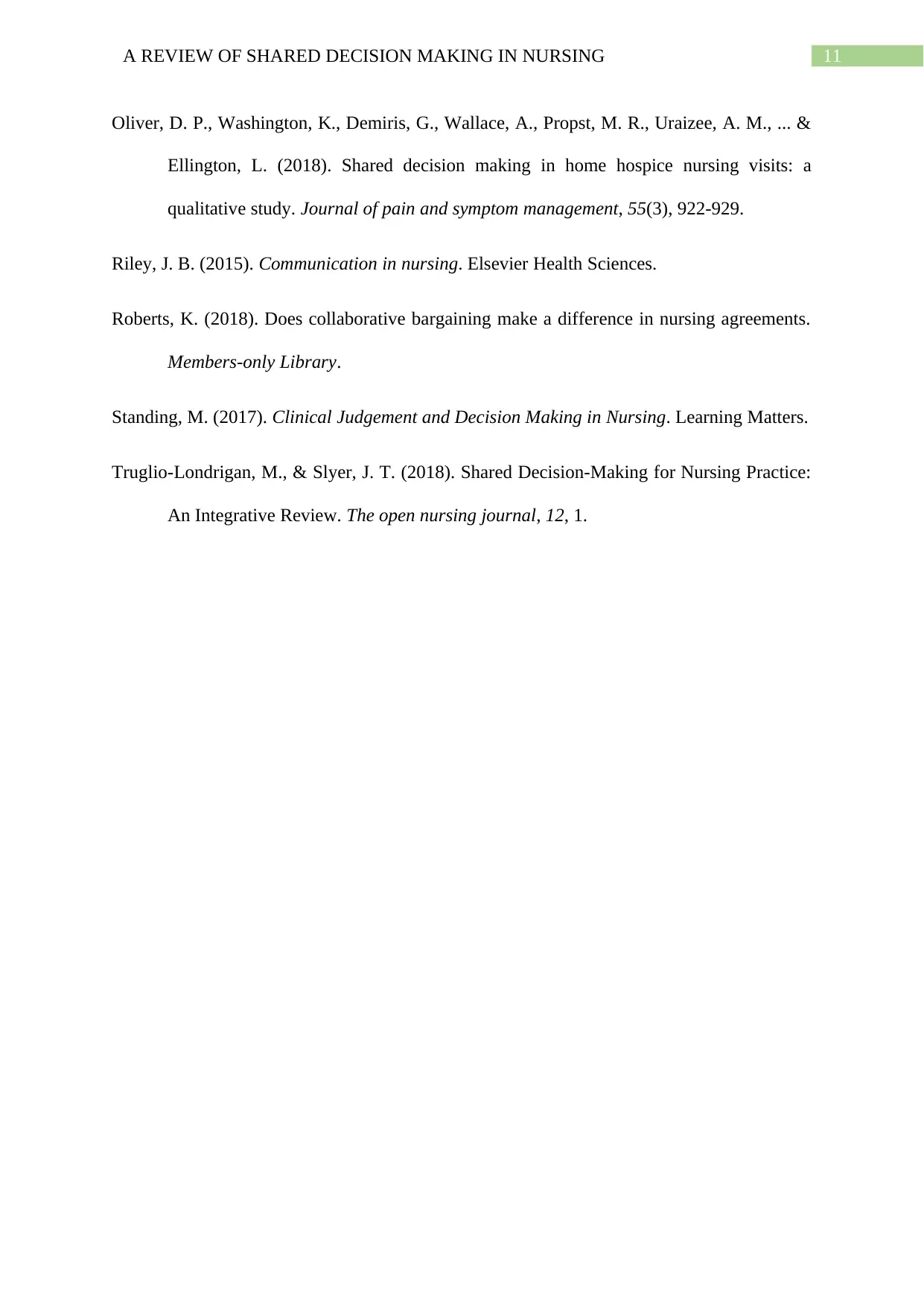
11A REVIEW OF SHARED DECISION MAKING IN NURSING
Oliver, D. P., Washington, K., Demiris, G., Wallace, A., Propst, M. R., Uraizee, A. M., ... &
Ellington, L. (2018). Shared decision making in home hospice nursing visits: a
qualitative study. Journal of pain and symptom management, 55(3), 922-929.
Riley, J. B. (2015). Communication in nursing. Elsevier Health Sciences.
Roberts, K. (2018). Does collaborative bargaining make a difference in nursing agreements.
Members-only Library.
Standing, M. (2017). Clinical Judgement and Decision Making in Nursing. Learning Matters.
Truglio-Londrigan, M., & Slyer, J. T. (2018). Shared Decision-Making for Nursing Practice:
An Integrative Review. The open nursing journal, 12, 1.
Oliver, D. P., Washington, K., Demiris, G., Wallace, A., Propst, M. R., Uraizee, A. M., ... &
Ellington, L. (2018). Shared decision making in home hospice nursing visits: a
qualitative study. Journal of pain and symptom management, 55(3), 922-929.
Riley, J. B. (2015). Communication in nursing. Elsevier Health Sciences.
Roberts, K. (2018). Does collaborative bargaining make a difference in nursing agreements.
Members-only Library.
Standing, M. (2017). Clinical Judgement and Decision Making in Nursing. Learning Matters.
Truglio-Londrigan, M., & Slyer, J. T. (2018). Shared Decision-Making for Nursing Practice:
An Integrative Review. The open nursing journal, 12, 1.
⊘ This is a preview!⊘
Do you want full access?
Subscribe today to unlock all pages.

Trusted by 1+ million students worldwide
1 out of 12
Related Documents
Your All-in-One AI-Powered Toolkit for Academic Success.
+13062052269
info@desklib.com
Available 24*7 on WhatsApp / Email
![[object Object]](/_next/static/media/star-bottom.7253800d.svg)
Unlock your academic potential
Copyright © 2020–2025 A2Z Services. All Rights Reserved. Developed and managed by ZUCOL.





